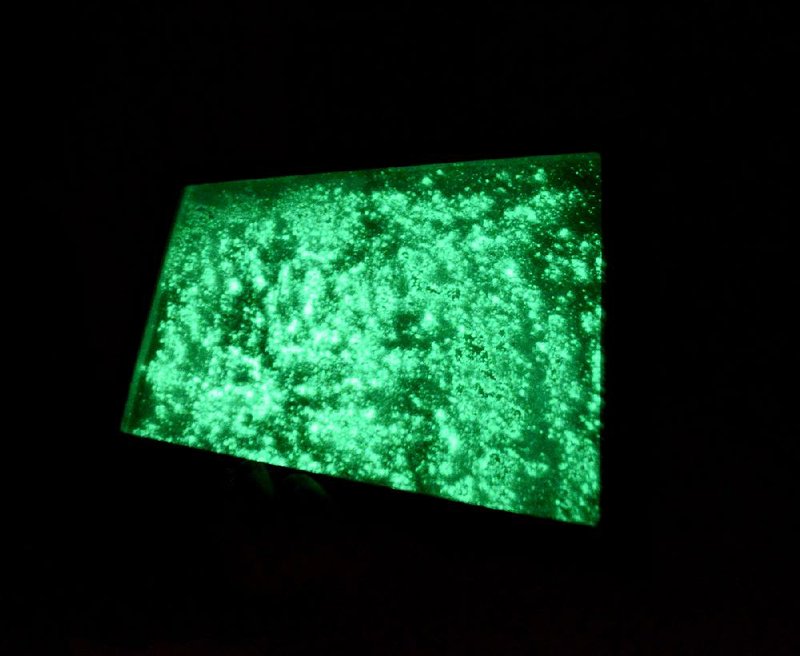SILOAM SPRINGS - Ron Hutcheson believes he has part of the solution to securing the country’s borders.
The Siloam Springs man developed a way to use a fluorescent, mineral-based material on road surfaces that would show heavy crossing areas.
“Everyone is thinking Star Wars, but it’s a John Wayne movie,” Hutcheson said of border security. “It’s not that complicated.”
His company, Sentry Visions, proposes building a 100-foot road that runs parallel to the nearly 2,000-mile U.S.-Mexican border with his fluorescent, nontoxic mineral-based material covering 40 feet on the southern side. The material draws radiation from the sun and glows during the night, showing foot traffic.
Nightly patrols would document crossing areas and give them to Border Patrol agents so they would know where to focus their efforts, he said. Hutcheson said it is a low-tech, low-cost solution to border security.
Mark Tocco has helped Hutcheson work through starting his business. Tocco is on the board of directors of the Northwest Arkansas Entrepreneurship Alliance. He is also an adviser for Northwest Arkansas SCORE, a free small-business counseling and mentoring program, which iswhere he met Hutcheson.
“I think his idea has some legs, but it is not a proven concept yet,” Tocco said. “He has to figure out how to do a proof of concept.”
A proof of concept involves entrepreneurs and start-ups demonstrating that a company or product is financially viable. It usually requires extensive research and review.
The U.S. Senate passed an immigration bill Thursday that proposes adding an additional $46 billion over 10 years to double the number of Border Patrol agents to about 40,000, complete a 700-mile fence and purchase high-tech surveillance equipment, including radar and drones.
Hutcheson estimates his process would cost about $200,000 a mile to install with an additional $10,000 to $15,000 needed each year for upkeep. The Congressional Budget Office, a nonpartisan federal agency, has estimated the average cost of building a fence at more than $3 million per mile.
The Department of Homeland Security attempted to build a virtual fence in 2005 through the Secure Border Initiative Network, or SBInet. The program was dropped in January 2011 because of high costs and low performance and for running behind schedule, according to a March 14 report by the Government Accountability Office. Boeing was in charge of the project, which cost nearly $1 billion to put in place along 54 miles of the Arizona-Mexico border.
This is no single solution to securing the border, Hutcheson said.
“There has to be a three- or four-prong approach,” he said. “My project fills a gap in existing technology.”
Hutcheson was sick and home-bound for almost 14 months four years ago. He said he spent a lot of time watching Border Wars on the National Geographic Channel and felt there had to be a better way to secure the border.
His curiosity led him to Bill Durham, a chemistry and biochemistry professor at the University of Arkansas at Fayetteville.
“He wanted something that would leave a footprint,” Durham said.
The professor happened to be working on an undergraduate lab problem about phosphors that would glow in the dark.
“Those two things just came together. It was fresh on my mind,” Durham said.
Hutcheson eventually came across the Japanese firm Nemoto and its Lumi-Nova phosphorescent product. Next, he needed to find the right product to put the pigment into. He eventually found Terra Pave International, a Texas-based eco-friendly paving company.
After a lot of experimenting,he found the right ratio to get a good footprint. He has applied for a patent for his idea and is seeking investors. Hutcheson said he has invested about $54,000 of his own money into Sentry Visions. He estimates sales revenue of $40 million and licensing revenue of $150 million in the first 10 years of commercialization.
Sentry Visions is a two person business: Hutcheson is joined by Pamela Hammersla, who serves as chief financial officer. The pair also own Lakeside Antiques in Siloam Springs.
Attempting to become a government contractor can be cumbersome. Tocco said there is a lot of paperwork that must be filled out just to be able to be considered. And there’s also the issue of getting noticed.Large firms such as Boeing get the lion’s share of defense spending.
Hutcheson attended the seventh annual Border Security Expo in Phoenix in March to gain exposure.
“Exhibiting at Border Security Expo is a great way to gain entrance and exposure to the U.S. Customs and border protection purchasing process,” said Kelvin Marsden-Kish, spokesman for Eagle Eye Expositions, which puts on the conference.
Marsden-Kish said he was not aware of any product similar to Sentry Visions’ and said it was one-of-a-kind at the show.
Hutcheson would eventually like to see other commercial users for the material such as hunters and small security firms, he said. Tocco said a commercial market may give Sentry Visions some traction.
“Entrepreneurs need to ask themselves if they are in the right market. Then they need to find out what it takes to commercialize the product and deploy it,” he said. “They’re still issues in each of those areas.”
Hutcheson’s best partner options would be a big player such as Boeing, Tocco said.
Business, Pages 63 on 06/30/2013

